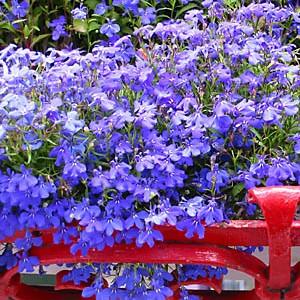
|
|
Annual
lobelia (Lobelia Erinus)
|
Lobelia
- (Lobelia spp.)
Lobelias
are hardy and tender, annuals and perennials that grow wild in various parts of the Northern and Southern
Hemispheres. There are over 200 species, but comparatively few are grown in the
garden. Those mainly grown range in size from the dwarf, compact annuals, which only grow a few inches
high, to the perennials, which grow 3 feet or more high.
The popular Lobelias that are used for summer
bedding, have been raised from L. Erinus, a blue-flowered variety.
Lobelia Erinus was introduced to Europe and America more than 200 years ago from the region around the Cape of Good
Hope. The original wild forms of lobelia have been bred to bloom more
profusely. The wild plant is straggling and grows about 6 inches high, but the varieties raised are compact and flower profusely in shades of
blue, white, purple and crimson with white eyes. Even though they are
perennials, they are grown as annuals.
Perennial Lobelias are upright, thick stemmed plants. They produce rich green or crimson foliage and large
flowers, usually bright scarlet, although there are now many varieties in pink and mauve hues and some have blue
flowers. These plants come from North America.
Native North American
species, often cultivated as ornamentals, include the only red lobelia, the cardinal flower
(L. cardinalis), which is becoming rare; the blue lobelia (L.
syphilitica), used by Native Americans for the treatment of syphilis; and Indian tobacco
(L. inflata), named for its odor.
The origin of the name, Lobelia
cardinalis, was named after the Belgian botanist, Mathias de
L’Obel who died in London in 1616. He often used a “latinized” form of his name
Lobelius. The name cardinalis was inspired by the color of the robes of the Roman Catholic
cardinals.
Lobelia cardinalis was first found by explorers in Canada who sent the plant to France in the
mid-1620’s. English botanist John Parkins wrote “the rich crimson cardinal
flower… it groweth neere the river in Canada, where the French plantation in America is
seated” from then on Lobelia cardinalis was known as the cardinal
flower.
The dried leaves and stems of Indian tobacco
(L. inflata) and sometimes of other species furnish medicinal lobelia, the source of
lobeline, which is used as a respiratory stimulant but is poisonous in overdose as are the
roots.
It is widely stated that
the alkaloid lobeline, is similar to nicotine in its effect on the body. Like
nicotine, it stimulates nerves in the central nervous system. In fact, lobeline has been used as a nicotine substitute in many
anti-smoking products and preparations designed to break the smoking
habit. In 1993, however, the U.S. Food and Drug Administration (FDA) prohibited the sale of
lobeline-containing smoking products because, according to the FDA
report, they lacked effectiveness in helping people quit or reduce
smoking.Ôhis belief appears to be a type of urban legend.
Source:
http://www.botany.com/lobelia.html
http://education.yahoo.com/reference/encyclopedia/entry/lobelia
http://medplant.nmsu.edu/cardinalis.htm
http://www.umm.edu/altmed/ConsHerbs/Lobeliach.html
